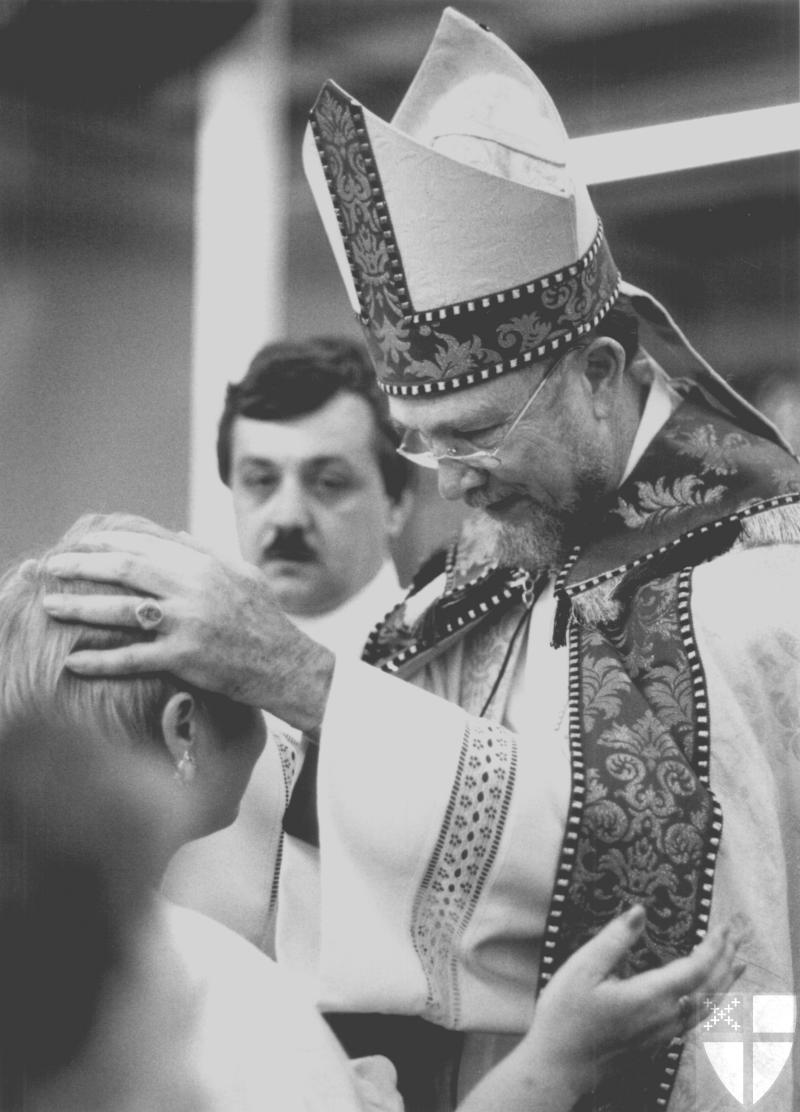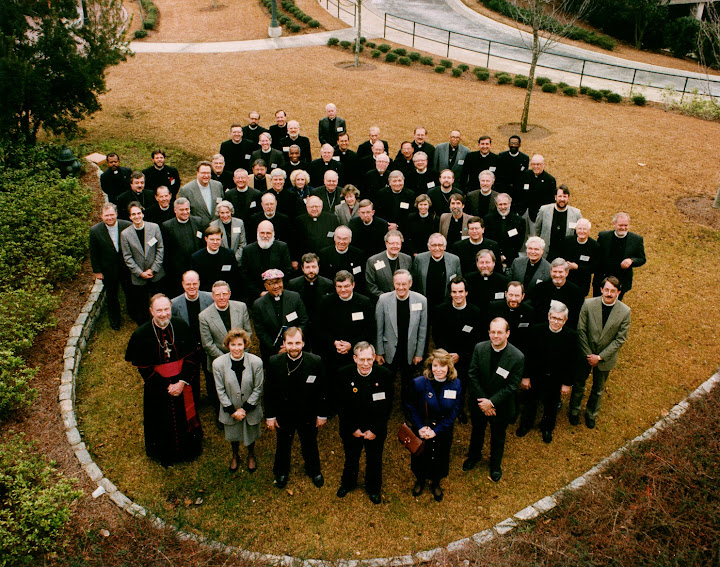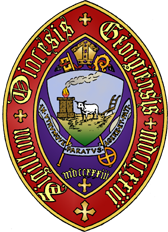The Episcopacy of the Right Reverend Harry Woolston Shipps
Eighth Bishop of Georgia
Written by the Rt. Rev. Harry W. Shipps
Bishop Shipps, born 28 January 1926, is a native of Bordentown, New Jersey. Married in 1953, he and his wife Louise have four children. He attended Bordentown High School, Bordentown Military Institute, and the New York State Maritime Academy. On 9 January 1946, he was commissioned an officer in the US Navy and the US Maritime Service. He sailed on a troop ship as a deck office, then with Grace Line Steamship Company until called to active duty in the Navy in 1953 during the Korean War, when he was assigned to a Naval facility in Savannah, GA, then to Naval shipboard duty on the North Atlantic. Discharged from active duty, he attended the School of Theology, University of the South as a postulant from the Diocese of Georgia being a parishioner of St. Paul’s Church, Savannah. In May 1958, the Rt. Rev’d Albert Rhett Stuart ordained him deacon in St. Luke’s Chapel, Sewanee, and assigned him as Vicar of St. Mark’s Church, Radium Springs, Albany, Ga. In January 1959, Bishop Shipps was ordained priest in his former parish, Christ Church, Bordentown, New Jersey, by The Rt. Rev’d Alfred L. Banyard, acting for the Bishop of Georgia.
From 1963 until 1970 Bishop Shipps served Holy Apostles, Savannah, then St. Alban’s, Augusta until 1983, when elected Bishop Coadjutor at a special convention of the diocese in St. John’s, Savannah in September, 1983. He was consecrated bishop at Christ Church, Savannah on Epiphany, 6 January 1984, The Most Rev’d John M. Allin chief consecrator, Bishop Alex D. Dickson and Bishop Reeves were co-consecrators and Bishop M. M. Benitez of Texas was the preacher. Bishop Shipps served as coadjutor to Bishop Reeves until 15 February 1985, when he was invested as diocesan bishop in St. Paul’s, Augusta. The Bishop of Atlanta, The Rt. Rev’d C. Judson Child served as preacher. Early in his episcopate, Bishop Shipps called the Rev’d J. Robert Carter, Vicar of Trinity Church, Statesboro to serve as Canon to the Ordinary. (Bishop Shipps is pictured here at his consecration.)
Bishop Shipps attended the 1988 Lambeth Conference in Canterbury, England, reporting to Diocesan Convention of 1989 that the experience was an exceptional educational experience making him deeply aware of the size and variety of cultures in the worldwide communion of 70,000,000 people.
While Vicar of St. Mark’s in Albany, in the 50’s and early 60’s Bishop Shipps served as priest in charge of St. John’s, a Black congregation. Committed to development of tolerance and inclusion in racial relations, he was publicly involved in Civil Rights throughout his ministry as parish priest. In his 1988 Diocesan convention address, he declared that ministry amongst Black Episcopalians was wanting, noting there were fewer Black Episcopalians in the diocese than had been the case for many years. He called for placement of clergy in congregations with no regard for race. In October 1994 he formed a diocesan Racism & African American Commission to promote understanding and full integration in the congregations of the diocese. He also formed a diocesan Peace and Environment Committee which produced a handbook on Christian Ecology for congregational guidance.
Bishop Shipps was a founding bishop of The Irenaeus Fellowship of Bishops, representing a moderate- conservative position in the House of Bishops. Meeting regularly, the group consisted of 64 members of the House of Bishops. To raise understanding of issues in the Episcopal Church locally, he brought a number of bishops to the diocese as speakers at Clergy Days, usually held in Dublin, and speakers for annual Diocesan Conventions, including The Very Rev’d David B Collins, President of the House of Deputies, The Very Rev’d Robert Giannini, Dean of the School of Theology, University of the South, The Most Rev’d Edmund L. Browning, Presiding Bishop, The Rt. Rev’d Desmond, OSF of the Companion diocese of Belize, The Rt. Rev’d Michael Marshall of London, Dr. Samuel Williamson, Chancellor of the University of the South and in February 1994, Dr. Joan Brown Campbell, President of the National Council of Churches and the first female and non-Episcopalian to be a Diocesan Convention speaker. Greetings were received in 1994 Convention from the Bishop of our Covenant diocese, the Roman Catholic Diocese of Savannah, The Most Rev’s Raymond W. Lessard, delivered by a deacon.
At the time of Bishop Shipps’ accession, there were 66 congregations in the diocese. Following Bishop Stuart’s example, Bishop Shipps organized an evangelistic campaign termed, as before, The Bishops’ Crusade. On 13 October 1986, twelve bishops from across the country were commissioned by Presiding Bishop John M. Allin in a service at Christ Church Savannah, then sent to twelve parishes around the diocese for a three day preaching mission and interaction with parishioners.
Bishop Shipps was active in the House of Bishops. A strong supporter of the 1979 Book of Common Prayer, he was Chair of the House of Bishops Prayer Book and Worship Committee at the 1994 General Convention. He served twelve years on the Episcopal Church Standing Commission on Ecumenical Relations, where he served as Chair of the Theological Committee. This Commission drew up the agreement with the ELCA Called to Common Mission. He participated in the Georgia Council of Churches, and formed an Ecumenical Commission in the diocese. Bishop Shipps and The Most Rev’d Raymond W. Lessard, Roman Catholic Bishop of Savannah, also an ecumenist, held several joint clergy conferences with noted speakers from both Churches. This led to a Covenant between the two dioceses calling for a number of programs and responsibilities on the part of each. The Covenant was ceremoniously signed by Bishop Shipps in St. Paul’s, Savannah with Bishop Lessard as witness; there followed a festive street procession to Sacred Heart Roman Catholic Church on Bull Street, where Bishop Lessard signed the document, witnessed by Bishop Shipps. (Bishops Lessard and Shipps are pictured together here on the day of the signing.)
In 1987, the diocesan convention Stewardship initiated a capital fund- raising campaign, Venture in Mission and Ministry for funds to be used in diocesan mission development and the needs of Honey Creek. Bishop Shipps reported to the 1989 and 1990 Conventions that $1, 100,000 of the goal of $1,500,000. Funds were designated for the development of property for four missions and for the further development of seven other missions. Funds were also assigned for improvements in the buildings at Honey Creek
Bishop Shipps placed emphasis on responsible stewardship for congregations of the diocese, and the imperative to look beyond ourselves to the worldwide community. He promoted firm commitment to the General Convention Asking program at a time when some parishes wished to withhold that portion of their diocesan pledge that would be paid to the General Convention budget, and substitute a program of their own choice; the bishop rejected this option as unacceptable to the concept of mutuality in the diocese.
 The bishop encouraged clergy well being, fellowship, and continuing education. Semi-annual Clergy Days were well attended in host parish Christ Church, Dublin, and included celebration of Holy Eucharist and presentation by a guest speaker; the controversial Bishop John S. Spong of Newark was one who drew considerable response. Silent monastic retreats were scheduled and, annually In Lent, diocesan clergy gathered at Christ Church, Dublin for Chrism Mass and Renewal of Vows. Annual Spring and Fall clergy conferences took place at Honey Creek. One such conference, with spouses in attendance, focused on spirituality and personality. This was led by psychologist the Rev’d Dr. Ruth Tiffany Barnhouse, using the Myers Briggs personality profile program. When Honey Creek was unavailable one year due to construction, the bishop provided a three day holiday on Jekyll Island for clergy and their families. Diocesan deacons also had regular conferences at Honey Creek as well as days of reflection, one led by The Rev’d Richard Reid of Virginia Seminary.
The bishop encouraged clergy well being, fellowship, and continuing education. Semi-annual Clergy Days were well attended in host parish Christ Church, Dublin, and included celebration of Holy Eucharist and presentation by a guest speaker; the controversial Bishop John S. Spong of Newark was one who drew considerable response. Silent monastic retreats were scheduled and, annually In Lent, diocesan clergy gathered at Christ Church, Dublin for Chrism Mass and Renewal of Vows. Annual Spring and Fall clergy conferences took place at Honey Creek. One such conference, with spouses in attendance, focused on spirituality and personality. This was led by psychologist the Rev’d Dr. Ruth Tiffany Barnhouse, using the Myers Briggs personality profile program. When Honey Creek was unavailable one year due to construction, the bishop provided a three day holiday on Jekyll Island for clergy and their families. Diocesan deacons also had regular conferences at Honey Creek as well as days of reflection, one led by The Rev’d Richard Reid of Virginia Seminary.
Initially opposed to the ordination of women to the priesthood, especially on grounds of impairment of ecumenical relations with the Roman Catholic Church, in the course of his episcopate Bishop Shipps instituted a listening process with clergy conferences to gauge diocesan reaction to possible ordination of women to the priesthood as permitted by 1976 General Convention. Strong division on both sides of the issue existed. In addition to other opportunities for dialogue the bishop brought the Presiding Bishop, The Most Rev’d Edmund L. Browning, to meet in St. Michael’s, Savannah, for open discussion on the issue with clergy and laity of the diocese. Marking a change in his previous position, Bishop Shipps initiated the process leading to ordination of women in both orders. Susan Harrison of Savannah was admitted to the process for vocational deaconate and ordained in September 1985. Sonia Sullivan of Valdosta was accepted for priesthood and attended seminary. At the Sullivan ordination in 1993 in Swainsboro, a large contingent of women priests from the Diocese of Atlanta were present in support.
Early dissent to the ordination of women had been organized and led by Fr. Richard Cantrell, Rector of St. John’s, Moultrie, who formed The Traditionalist Clergy of the Diocese of Georgia. Approximately a dozen diocesan priests attended meetings in Dublin, supported by Bishop Reeves, who came from his retirement home in North Carolina. Bishop Shipps attended several gatherings to explain his positions. The ordination issue led to a split in the congregation of St. John’s, Moultrie, resulting in formation of the congregation of St. Margaret of Scotland. Ultimately the ordination of women became a norm in the diocese and resistance faded into support, with the exception of St. John’s in Savannah, St. John’s Moultrie, and All Saints Thomasville. These three parishes also continued using the 1928 Book of Common Prayer with approval of the bishop, although the 1979 Book of Common Prayer was accepted by the large majority of congregations.
Following the custom of former bishops, Bishop Shipps published a regular editorial in the monthly diocesan newspaper, The Church in Georgia, and his diary of daily activities. Believing stewardship accountability and transparency important to the life of the diocese, he published growth statistics of the congregations and their responses to diocesan askings, and also financial accounting of diocesan funds.
 On Easter Eve 1990, before a congregation of over 800 persons and a 50 member choir and orchestra in the Church of the King in Valdosta, Bishop Shipps , with four neighboring bishops, confirmed 222 baptized persons from the formerly Pentecostal congregation. In the year before, The Rev’d Stanley White, pastor, approached Bishop Shipps about the process required for he and his congregation to enter the Episcopal Church. The canonical process was begun. Bishop Shipps encouraged the move and the canonical process was begun. He charged two nearby priests, Fr. H. Jacoba Hurst, St. Anne’s, Tifton and Fr. Henry I. Louttit, Jr, Christ Church, Valdosta, with preparing the pastor for ordination to the diaconate and priesthood, and the congregation for confirmation. Bishop John Howe of Central Florida was preacher at the service. In January 1991, having been ordained deacon, Fr. Stanley White was ordained to the priesthood and became Rector of the congregation now known as the Episcopal Church of Christ the King.
On Easter Eve 1990, before a congregation of over 800 persons and a 50 member choir and orchestra in the Church of the King in Valdosta, Bishop Shipps , with four neighboring bishops, confirmed 222 baptized persons from the formerly Pentecostal congregation. In the year before, The Rev’d Stanley White, pastor, approached Bishop Shipps about the process required for he and his congregation to enter the Episcopal Church. The canonical process was begun. Bishop Shipps encouraged the move and the canonical process was begun. He charged two nearby priests, Fr. H. Jacoba Hurst, St. Anne’s, Tifton and Fr. Henry I. Louttit, Jr, Christ Church, Valdosta, with preparing the pastor for ordination to the diaconate and priesthood, and the congregation for confirmation. Bishop John Howe of Central Florida was preacher at the service. In January 1991, having been ordained deacon, Fr. Stanley White was ordained to the priesthood and became Rector of the congregation now known as the Episcopal Church of Christ the King.
In Autumn 1990 the Diocese of Georgia inaugurated a Companion Diocese relationship with the Diocese of Belize in Central America. Accompanied by several laity, Bishop Shipps traveled to Belize to sign a covenant with Bishop Brother Smith, SSF. There followed mutual visits and various programs sponsored by parishes, including Partners in Progress, an education support for Belize children and a dental program for children, Project Smile.
In 1994 the diocesan budget was $1,350,211. The Georgia Episcopal Conference Center (Honey Creek) showed an operating surplus of $9,017. The Corporation of the Diocese reported a balance of $5,232,721. In 1994 the diocese reported 17,197 baptized persons. The bishop reported in his Convention Address that the Diocese of Georgia had the second highest average Sunday attendance of all 99 dioceses in the country and that our stewardship average per Sunday was also second highest in the Church.
 Noting that the Diocese of Georgia is one of few Episcopal Church dioceses without a cathedral, In 1993 Bishop Shipps designated St Paul’s, Savannah as his personal or Pro Cathedral, signing a document to this effect at a liturgical event in St. Paul’s. He named Fr. William Willoughby III Dean, and instituted five honorary Canons. Bishop Shipps’ retirement Eucharist was celebrated in St. Paul’s on 20 January 1995, followed by a diocesan banquet at a local hotel. Bishop Louttit’s consecration followed the next day at the Cathedral of St. John the Baptist at which time he received the crozier from Bishop Shipps.
Noting that the Diocese of Georgia is one of few Episcopal Church dioceses without a cathedral, In 1993 Bishop Shipps designated St Paul’s, Savannah as his personal or Pro Cathedral, signing a document to this effect at a liturgical event in St. Paul’s. He named Fr. William Willoughby III Dean, and instituted five honorary Canons. Bishop Shipps’ retirement Eucharist was celebrated in St. Paul’s on 20 January 1995, followed by a diocesan banquet at a local hotel. Bishop Louttit’s consecration followed the next day at the Cathedral of St. John the Baptist at which time he received the crozier from Bishop Shipps.
Bishop Shipps died November 17, 2016 and is buried at St. Paul the Apostle in Savannah, Georgia.

Bishop Shipps is pictured above with the clergy of the Diocese at a diocesan convention.
